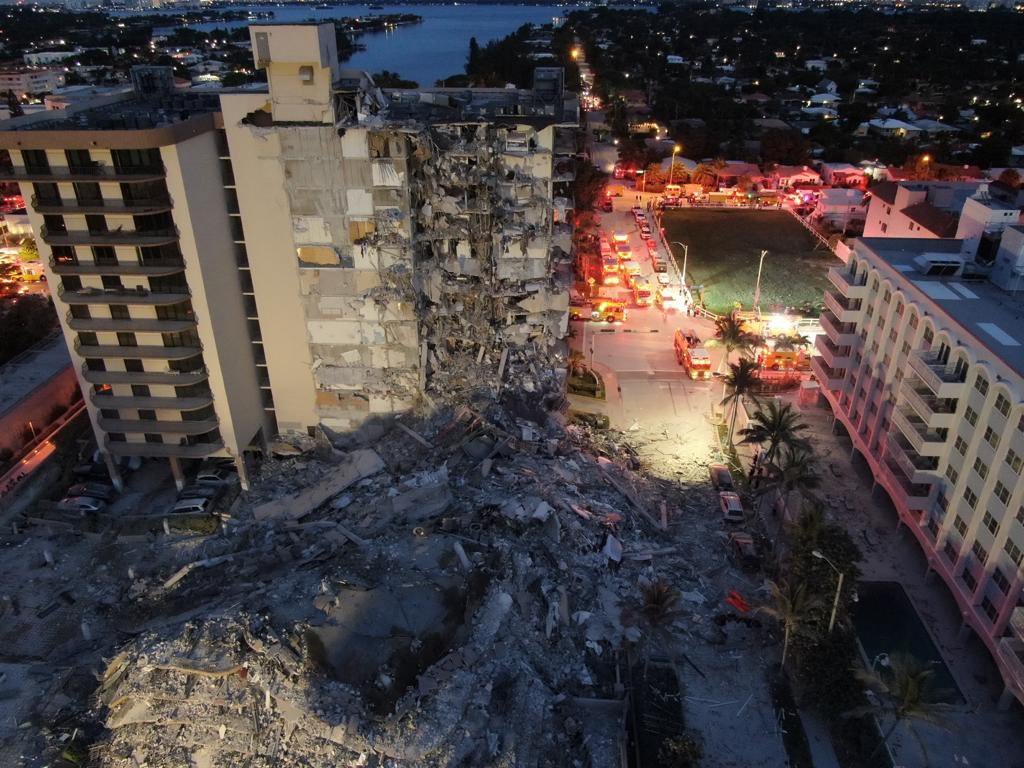
What Have We Learned? What Have We Not Done?
By The HOA Detective™ | June 24, 2025: Today, June 24th, 2025, marks the fourth anniversary of the Champlain Towers South Condominium (CTSC) collapse in Surfside, Florida — a tragedy that took 98 lives in the dead of night and sent shockwaves through the world of condominium governance and structural safety. For a moment, it appeared that a day of reckoning had arrived for regulators, the community management business and condo owners in certain situations, such as the ocean-front setting typical of thousands of owners in Florida and elsewhere.
There Should be NO Doubt: If you have any doubt about the level of institutional incompetence and negligence that contributed mightily to this unspeakable tragedy you can look no further than this 21-page PDF which is a copy of the email exchange between Frank Morabito, the structural engineer who authored the October 2018 Structural Field Survey Report MC Job# 18217 – the subject of which was the ill-fated CTSC – and then Treasure of the CTSC owners association, Maggie Manrara.
Bottom Line: Morabito clearly identified the conditions that led to the collapse more than 2 and 1/2 YEARS before the fateful morning of June 24, 2021. Not only did he put the CTSC Board on notice by delivering the report they had hired his firm to produce, Morabito took the additional step of delivering a copy of the PDF report to the Surfside, FL building department at which time the buck was passed to one Rosendo Prieto, described in early reports as a “former Surfside building official.”
At the time of the collapse, Prieto was in fact an employee of a privately held company called C.A.P. Government, Inc., which specializes in providing building department services exclusively to government clients like the city of Surfside, FL.
For his part, Prieto assured the CTSC Board that their building appeared to be “in very good shape.” He then took no action other than to announce to the world that he would be taking an extended leave of absence, 5 days after the collapse. At last report, neither Prieto nor C.A.P. Government, Inc. has been found legally liable for any damages arising from the disaster.
State [In]action: For its part, the Florida legislature jumped into action in the aftermath of the collapse when it started rattling its saber about changing the statutes that govern condominiums in Florida. Supported by industry status quo elements such as the Community Associations Institute (CAI), the legislature’s action could be categorized as damage control, considering that more than a decade before the collapse, lawmakers had repealed a 2008 statute that would have required buildings three stories or taller to conduct structural inspections every five years.
“Overwhelming Support:” In 2010, the Florida Legislature repealed this inspection mandate. The repeal was part of a broader 102-page community association reform bill (HB 663), which included a provision eliminating the five-year inspection requirement. The repeal passed with overwhelming support—111-3 in the House and 39-0 in the Senate—and was signed into law by then-Governor Charlie Crist.
The repeal was influenced by concerns over the financial burden of mandatory inspections, especially during the economic downturn following the Great Recession. Advocates for the repeal, including some condominium association lawyers and industry groups (CAI perhaps?), argued that the costs associated with the inspections were too high for many associations. Former state representative Julio Robaina, who sponsored the original 2008 bill, later expressed regret over the repeal, noting that it removed a critical mechanism for ensuring building safety.
What Have We Learned? To put it bluntly, not enough! In the wake of the collapse, one thing became clear: deferred maintenance can kill. The Champlain Towers South Condominium (CTSC) building was not undone by a sudden natural disaster, but by the slow, invisible creep of concrete deterioration, rebar corrosion, and a fractured decision-making process. Aided and abetted by inattentive building officials, a state legislature beholden to special interests, and a condominium Board that sat like a deer in the headlights unable or unwilling to act after being alerted to the compromised condition of their aging facility as far back as October of 2018.
- We have learned that many aging condo buildings, especially in coastal and humid climates, are ticking time bombs – particularly when Boards delay major capital repairs due to financial pressure or internal discord.
- We have learned that unit owners often lack visibility into the true condition of their buildings.
- We learned that reserve studies, when they exist at all, are too often treated as compliance formalities rather than urgent planning tools.
- We have learned that too many building owners are unwilling or unable to spend the kind of money required to properly maintain the facilities under their control.
- We have learned that we cannot depend on official or industry leaders to do the right thing.
- We have learned that politics and special-interest money is a powerful combination that too often serves to protect the status quo.
What Has Been Done? To put it bluntly, not nearly enough! The state of Florida finally responded to its 2010 misstep, AKA: HB 663, if no other reason to save face and control the damage in the aftermath of the 98 fatalities, ~$200M in property losses, and upwards of $1 BILLION in liability claims.
In 2022, the state enacted legislation mandating milestone inspections for condo buildings over three stories and more than 30 years old (25 years if within three miles of the coast), along with the new Structural Integrity Reserve Study (SIRS) requirement – intended to force HOA Boards to fund reserves for critical building elements adequately.
Insurers’ Response: One stakeholder group that did learn a thing or two from the collapse is the insurance industry, which has not only learned but has clearly acted with certainty. Casualty insurance premiums in Florida have skyrocketed. Meanwhile, the spill-over is now impacting states across the country, where economic losses due to natural disasters and fires have led to insurers abandoning certain markets altogether.
Underwriters have begun scrutinizing maintenance histories and inspection reports with a rigor unseen before. Associations that can’t demonstrate a proactive posture are being dropped or have been hit with premium increases many multiples of the annual inflation rate, with no end in sight.
Reserve study providers and engineers have been flooded with demand, especially in Florida. Many lack the staff or experience to perform structural reviews, especially reserve study providers who may or may not possess the credentials to conduct a structural building survey. A gold rush of sorts has ensued, resulting in a business environment in which questions of report quality and conflict-prone consulting relationships are even more of a concern.
A handful of states and municipalities have followed Florida’s lead in building safety reforms. But none have matched the scope of Florida’s SIRS law. Meanwhile, the enforcement of existing statutes in the handful of states that do require reserve studies continues to be negligible.
At the Heart of the Matter: The CTSC tragedy was a wake-up call. But America, for the most part, has hit the snooze button. The CAI – the world’s self-styled voice of HOAs – sprang into action not to reform the system, but to manage the narrative. Their post-collapse whitepapers urged “balanced” approaches and stressed “the need to avoid overregulation.” CAI lobbyists have consistently resisted mandatory full funding of reserves, deferring instead to “board discretion.”
Let’s Cut to the Chase: In the case of the CTSC collapse, “Board discretion” cost 98 people their lives! Half again as many people as who have died in the deadliest mass shooting in U.S. history! At the Federal level, there has been no meaningful legislative movement.
- No national reserve funding mandates have been enacted.
- No national inspection standards have been enacted.
- Although Fannie Mae and Freddie Mac did issue “temporary guidance” tightening lending criteria for structurally deficient buildings, these were later softened under industry pressure.
- Meanwhile, HUD remains largely silent.
Loopholes in a State Known for Loopholes: For all its apparent boldness, even Florida left massive loopholes in the state’s 2022 “reform” effort by not including an absolute requirement for structural engineers to be SIRS providers.
https://www.dia-corp.com/sirsfaq?
The 2022 statute also allows “phasing” of repairs without enforcement mechanisms. Perhaps most glaringly of all, it places the burden on volunteer boards to execute the mandates, with minimal training and oversight.
Millions in Legal Fees, But No Justice Reform: The lawsuits following the collapse have generated over $100 million in legal fees, by some estimates. Multiple law firms, engineering firms, insurers, and defendants have fought over liability.
Mediation has resulted in a historic $1.2 billion settlement fund – a remarkable figure of ~$12.245 million for each of the 98 lives lost. Funds that went primarily to unit owner survivors, not to system reform.
Morabito Association, the structural engineering consultant who tried in vain to warn the CTSC Board AND local Surfside building officials that the building was structurally compromised, has been named in more than two dozen lawsuits at last count. No sweeping changes in HOA insurance law or building governance emerged from the litigation.
What we saw, instead, was a perfect encapsulation of the post-tragedy American playbook: litigation and financial payouts to the aggrieved and an unknown number of the “usual suspects,” but no meaningful resolution of the fundamental problem.
Final Thoughts: The CTSC collapse was preventable; this much is clear. The tragedies’ many lessons are as uncomfortable as they are clear:
- We have learned that aging buildings need reinvestment, not deferral.
- We have learned that volunteer Boards, while well-meaning, are often unprepared for the weight of structural governance.
- We have learned that many condominium ownership groups are not prepared to absorb the true cost of maintaining a high-rise building, especially in a compromised location such as the CTSC building.
- We have learned that underfunding of reserves is not just a fiscal issue –
It can be a life-safety issue.
This anniversary should not be a ritual of remembrance alone. It should be a reckoning. Without enforceable standards, tragedy will repeat itself. Let us not wait for the next Champlain Towers to finally act.
Because You’re Buying More Than a Home!






